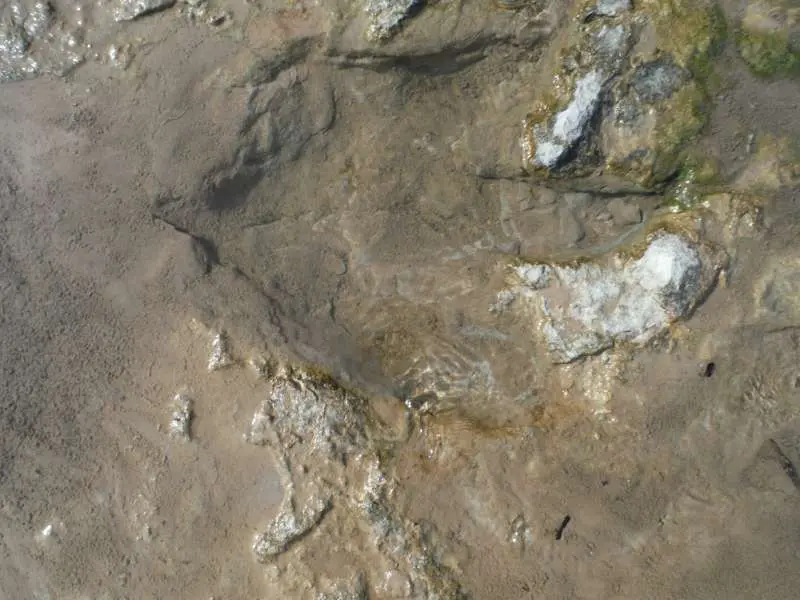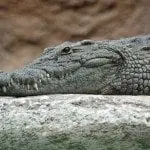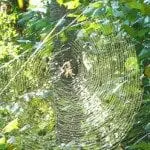
- A volunteer cleaning the fresh mud out of a dinosaur footprint fossil. Photo copyright Sara J. Bruegel, 2015
The sticky rubber material clung to my fingers, as I painted it onto the fossil dinosaur footprint. The rubbery mess on my hands bridged the gap between some fingers, reminding me of the webbed feet of a duck. Several weeks ago, I went to Glen Rose, Texas to work on dinosaur footprints in the Paluxy River bed (more about that here). The project I worked on was making a mold of one of the many Acrocanthosaurus footprints captured as fossils in the limestone layers. Working at Mt. Blanco Fossil Museum in Crosbyton, Texas, we make molds of many different kinds of fossils. These molds are used to make detailed replicas of the fossils.

To make a mold of a Glen Rose Acrocanthosaurus footprint, first we had to clear all the mud and debris out of the footprint that had been left there because of recent river flooding. The footprint we chose to mold was already exposed on the surface, so we didn’t dig through any of the hard limestone to get down to it this time. It really amazed me to look around this dig site and see the vast number of footprint fossils exposed all around – some disguised with mud or covered in water. Trying not to step on a fossil footprint was hard.
Once the dirt was cleared and any potential problems for the molding process were taken care of, we were ready to start painting on the first layer of wet latex rubber. The wet latex rubber we use is a little like the latex-based paint that is commonly used to paint the walls of a room, but much more rubbery. When wet, the latex gets into every little crevice and curve of the fossil, precisely capturing the smallest details. It takes several layers, or coats, of this latex, letting it dry between each layer to make the mold thick enough. It usually takes at least three layers of latex to make the rubber mold.

After making the latex rubber mold by painting the material into the fossil footprint, pressed into the limestone, we made a rigid “mother mold” out of plaster and burlap. We do this by mixing water with white plaster powder (made of the mineral, gypsum – the same white powdery material inside the sheetrock used in walls) to create a muddy white mixture. Dipping squares of burlap cloth in the wet plaster, we essentially make a plaster layer on top of latex rubber mold (putting a sheet of plastic between the two). We have to work quickly before plaster sets up. When the plaster hardens, this creates a sturdy form for the flexible rubber mold to keep it from deforming after they have both been carefully pulled away from the original footprint fossil. We can then use that two-part mold (the detailed, flexible rubber mold and hard, plaster “mother mold”) to make a precise replica of the footprint fossil we molded.
Making a mold that is supposed to be precisely conformed to the shape of the original fossil reminds me of how we are supposed to let God mold and make us, conforming us to the perfect image of Christ. Don’t let yourself become warped by the world – conform to the perfect image of Christ. Don’t compromise with dangerous ideas like evolution or long periods of time; rather, conform your thinking to the perfect, unchanging Word of God.
Copyright Sara J. Bruegel, 2015





